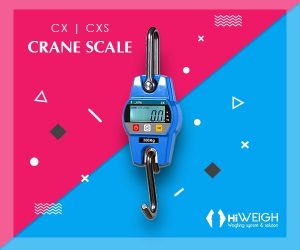Crane scales are convenient weight measuring instruments used across the business spectrum. Also known as hanging scales, these devices can measure different load capacities. For weighing equipment manufacturers, the China crane scale can be of great help due to its portability, robustness, rich features & functionalities, and cost effectiveness.
Most cutting-edge digital crane scale models come with features such as remote control calibration, overload warning indicators, palm hold indicator, power saving modes, and peak hold. Yet, there are subtle differences which influence buyers to opt for different models. The major differences come down to factors like capacity, usage, and functionalities. Let us take a look –
Crane Scale Selection: The Key Parameters
1. Intended application: The intended usage of a weighing scale is the first parameter to signify its efficiency. Crane scales find practical usage in various industries and applications including food products, sanitation equipment, and freight (rail, air, international shipping) among others. The hanging crane scales are used by industries that require accurate measurements of significantly heavier loads. In fact, business owners should focus on scales that match their application needs.
2. Weight handling capacity: The main purpose of a crane scale is to measure loads efficiently and give out accurate readings. However, a scale can only handle hanging loads within its specified weight handling capacity. This is why the China crane scale lists products that are within the specific weight limit groups. The capacity of such scales ranges from 300 kg to 200 ton. However, from a practical standpoint, a 100 ton capacity scale is not required should you only handle weights up to 100 kg.
3. Safety features: Heavy hanging loads need to be handled with careful precision in order to prevent a potential collapse. A collapse can cause severe injuries to workers and damage other equipment. If you are eager to invest in a crane scale, make sure it has adequate built-in safety measures. It is advisable to opt for scales that come with sturdy and rugged shackles along with a safety latch (or hook). This is to prevent weights from coming off the shackles. Another safety feature of modern scales is the overload warning indicator.
4. Accessibility and performance feature: Heavy-duty industrial crane scales should preferably have a flawless remote control operational ability. However, many users enjoy hands-free operation for it guarantees personal safety during weighing activities. Operational time (or battery life) is another variable that plays an important role in determining performance. Buyers also need to pay heed to other feature specifications i.e. safety load limit, tare value, zero range, operational distance (for remote control usage), accuracy, and power ratings.
5. Durability: The material used in the construction of a crane scale can impact its durability. The more durable and robust your scale is, less are the chances of operational mishaps and mechanical damage. The advantage of high durability also extends to the ease of maintenance and a hassle-free transportation. High-quality aluminum and stainless steel housing, along with zinc coated hooks are generally considered to be durable choices.
Conclusion
The aforementioned parameters are essential for the potential crane scale buyers to consider. Each of these parameters facilitates productivity, efficiency, and delivery of goods besides enhancing customer trust.

